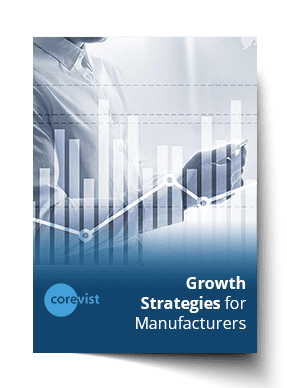Share
Author
George Anderson
Share
First published Jul 9, 2019. Refreshed Oct 13, 2021.
B2B eCommerce isn’t a set-it-and-forget-it operation. It takes planning and commitment to make ecommerce “sticky” with your customers. So how do you do it?
At Corevist, one of our core values is passion for our clients. By extension, that also means passion for our clients’ customers. That’s why we don’t stop at building and implementing Corevist solutions. We go beyond that and work with you to make your B2B ordering portal “sticky” for your customers.
First, you need to quantify stickiness. That means defining the metric to reach the business goal, such as the amount of revenue you want to flow through ecommerce. Once you’ve done that, you’re ready to craft a plan to get there–and your plan should cover the “4 stages of ecommerce stickiness,” as we like to call them.
In this article, we’ll talk about those 4 stages and what it takes to nail each one.
1. Onboarding: Driving first contact with the website
Onboarding is the first step in establishing stickiness. If customers never come to the B2B portal in the first place, they won’t become consistent users.
But onboarding is more than that. You need to communicate the value of the portal–how it makes life easier for them. After all, what’s in it for them? If the B2B portal can’t serve their needs, then picking up the phone or sending an email is still easier. (Hint: This is why the Corevist Platform includes comprehensive SAP ERP integration–so customers get the personalized data and logic they need to complete transactions.)
Since customer value is the key to onboarding, you need a smart plan for communicating that value and monitoring the progress of customer onboarding. Consider the different types of customers and develop a thoughtful plan to increase success for that segment. Throughout the onboarding process, you’ll want to engage in regular monitoring by asking questions like:
- Who HAS come to the website?
- Who HASN’T come to the website?
- Who hasn’t even opened their email invitations?
Onboarding is all about good communication with customers. Read more here: Crafting Your B2B eCommerce Rollout Care Package.
2. Adoption: From first contact to new normal
It’s not enough to drive onboarding to the B2B portal. Just because a customer sets up an account (or requests one) doesn’t mean they’ll start using the B2B portal day-in and day-out.
To achieve that, you’ll have to go the extra mile. And once again, it’s all about customer value.
So what does it take to drive real adoption? In a word, the new B2B portal has to provide exceptional value. It has to be a “better way to buy” than phone, fax and email (or whatever legacy channels you have in place). It has to provide a phenomenal customer experience.
We like to break up that exceptional value into two categories: Functionality and Training.
Functionality
Is your B2B customer portal easy to use? Does it provide the things B2B buyers really want? We’re not just talking about the basics which every B2C-oriented platform provides. No, the needs of B2B buyers go deeper:
- Plenty of product information to aid research.
- The same personalized pricing, including quantity discounts, which they would get from a Customer Service Representative.
- 100% accurate, real-time inventory/ATP information.
- Full order history and shipment status
- And MUCH more—see our 49 SAP integration points for a full overview.
Training
Let’s face it, some business processes are complex. A good B2B eCommerce platform doesn’t gloss over the complexities of your business—rather, it supports them while also making them easier for everyone involved.
That’s why your adoption plan must include training for customers on how to perform existing business processes in the new B2B eCommerce portal. That could mean training messages within the portal, in-person training, or online sessions. See this article for best practices: Crafting Your B2B eCommerce Rollout Care Package.
3. Growth: Beyond new normal to new value
Your B2B eCommerce portal is an avenue for growth. You should nurture it with strategic thinking about providing more value to your established customers (AND acquiring new customers).
How do you increase the value of the B2B portal for both segments? Here’s a high-level overview of best practices:
- Intelligent merchandising through cross-sell/upsell functionality to drive sales of related products which you manufacture.
- Offer 3rd party products so your customers only have to visit one eCommerce store to get everything they need for the job at hand. (Cross-sell/upsell functionality supports this, too).
- Run intelligent promotions and marketing campaigns to drive sales of ancillary products, phased-out products, or overstocked items.
4. Retention: If ecommerce is providing real value, customers shouldn’t want to leave
Once customers are onboarded, have adopted B2B eCommerce, and are getting increasing value, they shouldn’t want to leave. But how can you go the extra mile to really retain your customers?
True retention requires everything we’ve already mentioned, and it benefits from best practices like these:
- Continuously evolve and improve your ecommerce functionality (we do this constantly with the Corevist Platform).
- Continuously refresh your ecommerce content, including educational material, so customers get new value every time they visit the web store.
- Monitor your ecommerce health constantly to see which products are performing, which customer segments are least engaged, and more.
- Use the insights you glean from metrics to craft the next iteration of your marketing efforts.
NEW Report:
Growth Strategies for Manufacturers
Every manufacturer needs to grow in the digital age. Here’s the ultimate guide to growth strategies for manufacturers. Read now.










